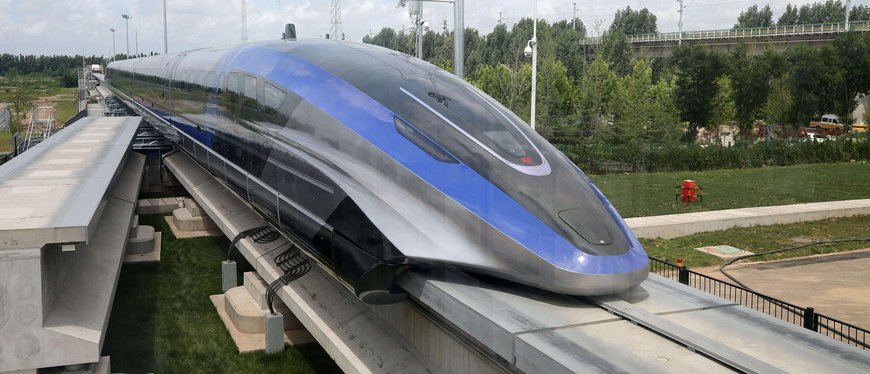Opinion: The need for speed
This week, China’s rail ambitions culminated in the unveiling of a high-speed Maglev train capable of speeds up to 600 km/h.

The new vehicle has been in the offing since 2016, underscoring the remarkable pace at which Chinese R&D operates.
Produced by state-owned CRRC from its Qingdao Sifang factory, the Maglev levitates above its track without contact. While this technology is not new and various prototypes have been tested around the world, there are presently only six commercially operating Maglev systems. All of these are in Asia, namely Japan, South Korea and Mainland China and so far, none of these existing systems have achieved an operational speed anything like 600 km/h.
China is not alone in its ambition – this development allows the nation to join the ranks of the Japanese, whose most recent Maglev train achieved a top speed of 603 km/h in April 2021. It is not currently clear whether the quoted 600km/h is the Chinese train’s operational speed or its maximum speed; more will be revealed in due course.
While the Japanese system is set to be ready for commercial passengers between Tokyo and Nagoya in 2027, there is as yet no known application for the Chinese train.
A New Era
These Chinese and Japanese developments herald a new era of ultra-high-speed rail; both countries pride themselves on expansive HSR networks.
The Japanese have the oldest HSR network in the world, commencing in 1964 when the Tokaido Shinkansen Line between Tokyo and Shin-Osaka opened in time for the Tokyo Olympics. The Japanese HSR network claims the impressive feat of no passenger fatalities or injuries due to accidents in all the time that it has been running.
Conversely, the Chinese HSR network commenced in 2008 in time for the Beijing Olympics, perhaps taking a note from the Japanese playbook. Today China’s HSR network accounts for two-thirds of the world’s total HSR network with (for those residing in countries yet to embrace HSR) an eye watering 38,000 km of track length.
‘Old School’ HSR Rail
Outside of these Chinese and Japanese developments, the fastest railways in the world are:
- Shanghai Maglev - 430km/h
- The Harmony CRH 380A - 380km/h (running from Beijing to Shanghai)
- AGV Italo - 360 km/h (running on the Napoli – Roma – Firenze – Bologna – Milano corridor)
- Siemens Velaro E/EVS103 - 350km/h (running between Barcelona – Madrid)
- Talgo 350 – 350 km/h (running Madrid-Zaragoza-Lleida section of the Madrid-Barcelona line)
- E5 Series Shinkansen Hayabusa - 300 km/h (running on the Tohoku Shinkansen Line in Japan)
Each of these trains are capable of, and have proven, testing speeds well in excess of their operational speeds, but none of them close to the 600km/h of the new Chinese and Japanese Maglev vehicles.
The latest developments by the Chinese and Japanese fills an important gap in the railway market. While traditional HSR systems are aimed at distances under 1,000 kms in length, ultra-high-speed rail produces a viable alternative for land transportation for distances of around 1,500 kms in length.
It also challenges the need and purpose of Hyperloop technology. Hyperloop aims to operate at distances greater than 1,000 kms but has yet to overcome countless technical and safety challenges. The introduction of ultra-high-speed Maglev systems will push hyperloop to try to identify substantial cost or advantages or even higher speeds.
High-Speed Rail for Everyone?
With the move toward greater environmental consciousness, travel by air is increasingly viewed as a wasteful luxury.
For example, legislation like the French Climate and Resilience law passed on 20th July 2021, includes the cessation of short-haul flights for connections that can be made by train in less than 2.5 hours.
Then there is the ‘flight shame’ movement, pressuring people to feel more accountable for their carbon footprint. A UK NGO ran a “Flight Free 2020” campaign inspired by the Swedish Flygfritt (flight free) movement and this has been copied by other NGOS in Canada, Belgium and France.
Whatever the driver, the railway renaissance is far from over. It’s no coincidence that the HSR powerhouses of Japan and China see the opportunity and are jumping onboard. Their technology is edging its way into the longer-haul rapid transit, deliberately eating into the domestic airline market. While airlines grapple with survival during COVID era low ticket numbers, railways are champing at the bit to enter the world stage for another hurrah.
And yet there is a long way to go. HSR technology is known to be operating in only 26 countries around the world. Many wealthy nations, including those ranked in the world’s top 20 economies, still don’t have HSR technology - the US (presently operating below 300km/h), Australia, India, Canada, Brazil, Mexico and Indonesia.
In years to come, will people look back and shudder at the thought of flying across the country for a meeting? Whether due to COVID related travel bans, ease of video conferencing or 600km/h Maglev trains, it seems likely that short haul air travel will find it increasingly hard to compete.
The coming decade will determine the future of maglev technology. The question is no longer whether it is technologically viable or safe, but whether it’s commercially feasible. The Shanghai Maglev has reportedly not generated adequate profits to breakeven. Commercial viability will determine who will win the race to drive maglev technology into mainstream rail transportation and whether you’ll be levitating to your next holiday destination or business meeting.
www.ricardo.com

